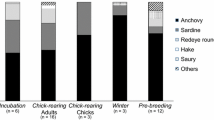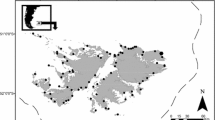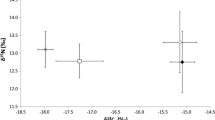Abstract
Northern Macronectes halli and southern giant petrels M. giganteus are opportunistic predators and the dominant avian scavengers in sub-Antarctic and Antarctic ecosystems. At South Georgia, there are globally important breeding populations of both species; however, no detailed diet study has been carried out at this site for > 35 years. Here, we analysed stomach contents of northern (n = 81) and southern giant petrel (n = 73) chicks at Bird Island, South Georgia (2014/15–2016/17). Specifically, we investigated: (1) interspecific and sexual dietary segregation; (2) diet changes within and among recent years; and (3) long-term diet changes since 1979/80–1980/81. Overall diet composition was similar between species, with penguins comprising approximately half the diet by mass. In both species (but more pronounced in southern giant petrels), prey delivered by female parents included higher proportions (by mass) of penguins and Antarctic krill Euphausia superba, and by male parents included more Antarctic fur seal Arctocephalus gazella carrion and seabirds other than penguins. Consumption of penguins increased, and of seal carrion declined, as chick-rearing progressed, mirroring the decreasing availability of the latter after the peak pup** period in December at South Georgia. Comparisons with data from 1979/80–1980/81 suggest some changes in giant petrel diets; however, these differences were no greater than the typical annual variation, and there were no clear links between diet and breeding allochrony or the differing population trends (more rapid increase in northern than southern giant petrels). The high diet diversity and ability of giant petrels to exploit both carrion and marine prey facilitates coexistence with other sympatric Procellariiformes and explains their favourable population status.





Similar content being viewed by others
Data availability
Supporting data are available from the corresponding author upon reasonable request.
References
Atkinson A, Whitehouse MJ, Priddle J, Cripps GC, Ward P, Brandon MA (2001) South Georgia, Antarctica: a productive, cold water, pelagic ecosystem. Mar Ecol Prog Ser 216:279–308
Berrow SD, Croxall JP (1999) The diet of white-chinned petrels Procellaria aequinoctialis, Linnaeus 1758, in years of contrasting prey availability at South Georgia. Antarct Sci 11:283–292
Berrow SD, Croxall JP, Grant SD (2000) Status of white-chinned petrels Procellaria aequinoctialis Linnaeus 1758, at Bird island, South Georgia. Antarct Sci 12:399–405
Boltovskoy D (1999) South Atlantic Zooplankton. Backhuys Publishers, Leiden
Bonner WN, Hunter S (1982) Predatory interactions between Antarctic fur seals, macaroni penguins and giant petrels. Br Antarct Surv Bull 56:75–79
Bourne WRP, Warham J (1966) Geographical variation in the giant petrels of the genus Macronectes. Ardea 54:45–67
Boyd IL (1989) Spatial and temporal distribution of Antarctic fur seals (Arctocephalus gazella) on the breeding grounds at Bird Island, South Georgia. Polar Biol 10:179–185
Boyd IL (1993) Pup production and distribution of breeding Antarctic fur seals (Arctocephalus gazella) at South Georgia. Antarct Sci 5:17–24
Brown RM, Techow NMSM, Wood AG, Phillips RA (2015) Hybridization and back-crossing in giant petrels (Macronectes giganteus and M. halli) at Bird Island, South Georgia, and a summary of hybridization in seabirds. PLoS ONE 10:e0121688
Burnham KP, Anderson DR (2002) Model selection and inference: a practical information-theoretic approach. Springer, New York
Cairns DK (1987) Seabirds as indicators of marine food supplies. Biol Oceanogr 5:261–271
Church GE, Furness RW, Tyler G, Gilbert L, Votier SC (2018) Change in the North Sea ecosystem from the 1970s to the 2010s: great skua diets reflect changing forage fish, seabirds, and fisheries. ICES J Mar Sci 76:925–937
Clarke MR (1986) A handbook for the identification of cephalopod beaks. Clarendon Press, Oxford
Clarke A, Croxall JP, Poncet S, Martin AR, Burton R (2012) Important bird areas: South Georgia. Br Birds 105:118–144
Conroy J (1972) Ecological aspects of the biology of giant petrel Macronectes giganteus (Gmelin) in the maritime Antarctic. Br Antarct Surv Sci Rep 75:1–74
Copello S, Quintana F, Pérez F (2008) Diet of the southern giant petrel in Patagonia: fishery-related items and natural prey. Endanger Species Res 6:15–23
Corá DH, Finger JVG, Krüger L (2020) Coprophagic behaviour of southern giant petrels (Macronectes giganteus) during breeding period. Polar Biol 43:2111–2116
Croxall JP, Prince PA (1979) Antarctic seabird and seal monitoring studies. Polar Rec 19:573–595
Croxall JP, Prince PA (1980) Food, feeding ecology and ecological segregation of seabirds at South Georgia. Biol J Linn Soc 14:103–131
Croxall JP, Prince PA, Reid K (1997) Dietary segregation of krill-eating South Georgia seabirds. J Zool 242:531–556
De Bruyn PJN, Cooper J, Bester MN, Tosh CA (2007) The importance of land-based prey for sympatrically breeding giant petrels at sub-Antarctic Marion Island. Antarct Sci 19:25–30
Descamps S, Gauthier-Clerc M, Le Bohec C, Gendner JP, Le Maho Y (2005) Impact of predation on king penguin Aptenodytes patagonicus in Crozet Archipelago. Polar Biol 28:303–310
Dilley BJ, Davies D, Connan M, Cooper J, de Villiers M, Swart L, Vandenabeele S, Ropert-Coudert Y, Ryan PG (2013) Giant petrels as predators of albatross chicks. Polar Biol 36:761–766
Duffy DC, Jackson S (1986) Diet studies of seabirds: a review of methods. Colon Waterbirds 9:1–17
Dunn MJ, Jackson JA, Adlard S, Phillips RA (2016) Population size and trends of southern giant petrels (Macronectes giganteus) nesting at Signy Island, South Orkney Islands. Polar Biol 39:1309–1317
Forero MG, González-Solís J, Hobson KA, Donázar JA, Bertellotti M, Blanco G, Bortolotti GR (2005) Stable isotopes reveal trophic segregation by sex and age in the southern giant petrel in two different food webs. Mar Ecol Prog Ser 296:107–113
Forster IP, Phillips RA (2009) Influence of nest location, density and topography on breeding success in the black-browed albatross Thalassarche melanophris. Mar Ornithol 37:213–217
Gianuca D, Votier SC, Pardo D, Wood AG, Sherley RB, Ireland L, Choquet R, Pradel R, Townley S, Forcada J, Tuck GN, Phillips RA (2019) Sex-specific effects of fisheries and climate on the demography of sexually dimorphic seabirds. J Anim Ecol 88:1366–1378
González-Solís J (2004) Sexual size dimorphism in northern giant petrels: ecological correlates and scaling. Oikos 105:247–254
González-Solís J, Croxall JP (2005) Differences in foraging behaviour and feeding ecology in giant petrels. In: Ruckstuhl KE, Neuhaus P (eds) Sexual segregation in vertebrates: ecology of the two sexes. Cambridge University Press, Cambridge, pp 92–111
González-Solís J, Croxall JP, Wood AG (2000a) Foraging partitioning between giant petrels Macronectes spp. and its relationship with breeding population changes at Bird Island. South Georgia Mar Ecol Prog Ser 204:279–288
González-Solís J, Croxall JP, Wood AG (2000b) Sexual dimorphism and sexual segregation in foraging strategies of northern giant petrels, Macronectes halli, during incubation. Oikos 90:390–398
González-Solís J, Croxall JP, Afanasyev V (2008) Offshore spatial segregation in giant petrels Macronectes spp.: differences between species, sexes and seasons. Aquat Conserv Mar Freshw Ecosyst 17:S22–S36
Granroth-Wilding HMV, Phillips RA (2019) Segregation in space and time explains the coexistence of two sympatric sub-Antarctic petrels. Ibis 161:101–116
Harper PC (1987) Feeding behaviour and other notes on 20 species of Procellariiformes at sea. Notornis 34:169–192
Hill H (1990) A new method for the measurement of Antarctic krill Euphausia superba Dana from predator food samples. Polar Biol 10:317–320
Horswill C, Matthiopoulos J, Green JA, Meredith MP, Forcada J, Peat H, Preston M, Trathan PN, Ratcliffe N (2014) Survival in macaroni penguins and the relative importance of different drivers: individual traits, predation pressure and environmental variability. J Anim Ecol 83:1057–1067
Horswill C, Ratcliffe N, Green JA, Phillips RA, Trathan PN, Matthiopoulos J (2016) Unravelling the relative roles of top-down and bottom-up forces driving population change in an oceanic predator. Ecology 97:1919–1928
Hunter S (1983) The food and feeding ecology of the giant petrels Macronectes halli and M. giganteus at South Georgia. J Zool 200:521–538
Hunter S (1984) Breeding biology and population dynamics of giant petrels Macronectes at South Georgia (Aves: Procellariiformes). J Zool 203:441–460
Hunter S (1985) The role of giant petrels in the Southern Ocean ecosystem. In: Siegfried RW, Condy PR, Laws MR (eds) Antarctic nutrient cycles and food webs. Springer, Berlin, pp 534–542
Hunter S (1987) Species and sexual isolating mechanisms in sibling species of giant petrels Macronectes. Polar Biol 7:295–301
Hunter S, Brooke MDL (1992) The diet of giant petrels Macronectes spp. at Marion Island. Southern Indian Ocean Colon Waterbirds 15:56–65
Johnstone G (1977) Comparative feeding ecology of the giant petrels Macronectes giganteus (Gmelin) and M. halli (Mathews). In: Llano G (ed) Adaptations within Antarctic ecosystems. Smithsonian Institute, Washington, pp 647–688
Jones CW, Risi MM, Cooper J (2019) An incubating northern giant petrel actively feeds on a Salvin’s prion. Antarct Sci 31:317–318
Kirkwood J (1984) A guide to the Decapoda of the Southern Ocean. ANARE Res Notes 11:1–47
Martin AR, Poncet S, Barbraud C, Foster E, Fretwell P, Rothery P (2009) The white-chinned petrel (Procellaria aequinoctialis) on South Georgia: population size, distribution and global significance. Polar Biol 32:655–661
McInnes JC, Raymond B, Phillips RA, Jarman SN, Lea MA, Alderman R (2016) A review of methods used to analyse albatross diets—assessing priorities across their range. ICES J Mar Sci 73:2125–2137
Mills WF, Xavier JC, Bearhop S, Cherel Y, Votier SC, Waluda CM, Phillips RA (2020) Long-term trends in albatross diets in relation to prey availability and breeding success. Mar Biol 167:29
Moreno R, Stowasser G, McGill RAR, Bearhop S, Phillips RA (2016) Assessing the structure and temporal dynamics of seabird communities: the challenge of capturing marine ecosystem complexity. J Anim Ecol 85:199–212
Payne M (1977) Growth of a fur seal population. Philos Trans R Soc London B 279:67–79
Phillips RA (2006) Efficacy and effects of diet sampling of albatross chicks. Emu 106:305–308
Phillips RA, Petersen MK, Lilliendahl K, Solmundsson J, Hamer KC, Camphuysen CJ, Zonfrillo B (1999) Diet of the northern fulmar Fulmarus glacialis: reliance on commercial fisheries? Mar Biol 135:159–170
Phillips RA, Phalan B, Forster IP (2004) Diet and long-term changes in population size and productivity of brown skuas Catharacta antarctica lonnbergi at Bird Island, South Georgia. Polar Biol 27:555–561
Phillips RA, Silk JRD, Croxall JP (2005) Foraging and provisioning strategies of the light-mantled sooty albatross at South Georgia: competition and co-existence with sympatric pelagic predators. Mar Ecol Prog Ser 285:259–270
Phillips RA, McGill RAR, Dawson DA, Bearhop S (2011) Sexual segregation in distribution, diet and trophic level of seabirds: insights from stable isotope analysis. Mar Biol 158:2199–2208
Poncet S, Wolfaardt AC, Black A, Browning S, Lawton K, Lee J, Passfield K, Strange G, Phillips RA (2017) Recent trends in numbers of wandering (Diomedea exulans), black-browed (Thalassarche melanophris) and grey-headed (T. chrysostoma) albatrosses breeding at South Georgia. Polar Biol 40:1347–1358
Poncet S, Wolfaardt AC, Barbraud C, Reyes-Arriagada R, Black A, Powell RB, Phillips RA (2020) The distribution, abundance, status and global importance of giant petrels (Macronectes giganteus and M. halli) breeding at South Georgia. Polar Biol 43:17–34
Prince PA, Morgan RA (1987) Diet and feeding ecology of Procellariiformes. In: Croxall JP (ed) Seabirds: feeding ecology and role in marine ecosystems. Cambridge University Press, Cambridge, pp 135–171
R Core Team (2019) R: a language and environment for statistical computing. Vienna, Austria. https://www.R-project.org/
Raya Rey A, Polito M, Archuby D, Coria N (2012) Stable isotopes identify age-and sex-specific dietary partitioning and foraging habitat segregation in southern giant petrels breeding in Antarctica and southern Patagonia. Mar Biol 159:1317–1326
Reisinger RR, Carpenter-Kling T, Connan M, Cherel Y, Pistorius PA (2020) Foraging behaviour and habitat-use drives niche segregation in sibling seabird species. R Soc Open Sci 7:200649
Ryan PG, Sommer E, Breytenbach E (2008) Giant petrels Macronectes hunting northern rockhopper penguins Eudyptes moseleyi at sea. Ardea 96:129–134
Techow N, O’Ryan C, Phillips R, Gales R, Marin M, Patterson-Fraser D, Quintana F, Ritz M, Thompson D, Wanless R, Weimerskirch H, Ryan P (2010) Speciation and phylogeography of giant petrels Macronectes. Mol Phylogenet Evol 54:472–487
Thomas G (1982) The food and feeding ecology of the light-mantled sooty albatross at South Georgia. Emu 82:92–100
Towers J, Gasco N (2020) Giant petrels (Macronectes spp.) prey on depredating sperm whales (Physeter macrocephalus). Polar Biol 43:919–924
Votier SC, Bearhop S, MacCormick A, Ratcliffe N, Furness RW (2003) Assessing the diet of great skuas, Catharacta skua, using five different techniques. Polar Biol 26:20–26
Votier SC, Furness RW, Bearhop S, Crane JE, Caldow RWG, Catry P, Ensor K, Hamer KC, Hudson AV, Kalmbach E, Klomp NI, Pfeiffer S, Phillips RA, Prieto I, Thompson DR (2004) Changes in fisheries discard rates and seabird communities. Nature 427:727–730
Waluda CM, Hill SL, Peat HJ, Trathan PN (2012) Diet variability and reproductive performance of macaroni penguins Eudyptes chrysolophus at Bird Island, South Georgia. Mar Ecol Prog Ser 466:261–274
Williams TD, Croxall JP (1991) Annual variation in breeding biology of macaroni penguins, Eudyptes chrysolophus, at Bird Island, South Georgia. J Zool 223:189–202
Xavier JC, Cherel Y (2009) Cephalopod beak guide for the Southern Ocean. British Antarctic Survey, Cambridge
Xavier JC, Croxall JP, Trathan PN, Rodhouse PG (2003) Inter-annual variation in the cephalopod component of the diet of the wandering albatross, Diomedea exulans, breeding at Bird Island, South Georgia. Mar Biol 142:611–622
Acknowledgements
The authors are grateful to Alastair Wilson, Jerry Gilham, Tegan Newman and the other fieldworkers at Bird Island who helped with sampling of giant petrel diets, and to Dr José Xavier for identification of cephalopod beaks. Constructive comments from four anonymous reviewers substantially improved this work. W.F.M was supported by a NERC GW4+ Doctoral Training Partnership studentship from the Natural Environment Research Council (NE/L002434/1). This work represents a contribution to the Ecosystems component of the British Antarctic Survey Polar Science for Planet Earth Programme, funded by the Natural Environment Research Council.
Author information
Authors and Affiliations
Contributions
WFM and RAP contributed to the concept and design of the study. TIM collected samples in the field. WFM and TIM analysed the data. WFM wrote the initial manuscript draft. All authors contributed to the writing of the manuscript and gave final approval for publication.
Corresponding author
Ethics declarations
Conflict of interest
The authors declare no conflict of interest.
Ethical approval
Diet sampling was approved by the British Antarctic Survey Ethics Committee and carried out with permission of the Government of South Georgia and the South Sandwich Islands.
Additional information
Responsible Editor: V. Paiva.
Reviewers: undisclosed experts.
Publisher's Note
Springer Nature remains neutral with regard to jurisdictional claims in published maps and institutional affiliations.
Supplementary Information
Below is the link to the electronic supplementary material.
Rights and permissions
About this article
Cite this article
Mills, W.F., Morley, T.I., Votier, S.C. et al. Long-term inter- and intraspecific dietary variation in sibling seabird species. Mar Biol 168, 31 (2021). https://doi.org/10.1007/s00227-021-03839-6
Received:
Accepted:
Published:
DOI: https://doi.org/10.1007/s00227-021-03839-6




